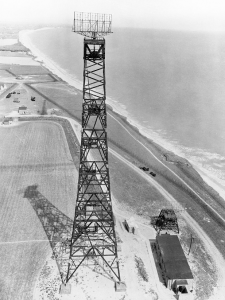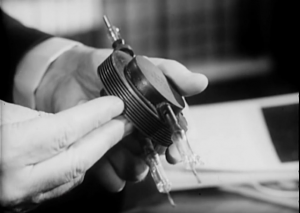1940-42 Worth
Telecommunications
Research
Establishment
TRE General Introduction
Based on A.P. Rowe’s Obituary 1976, written by Sir Bernard Lovell 19.
Readers should reflect on the extra-ordinary secret establishment at Worth Matravers and its Superintendent, Albert Percival Rowe (1898-1976), who controlled the Telecommunications Research Establishment (TRE) Worth during part of the Second World War 1940-42. A radar pioneer and university vice-chancellor, born on 23 March 1898 at Launceston, Cornwall, England, son of Albert Rowe, sewing-machine agent, and his wife Mary Annie, née Goudge. Young Albert attended the Portsmouth Dockyard School and studied physics at the Royal College of Science, University of London (B.Sc. Hons, 1922). He joined a defence science unit of the Air Ministry, and lectured part time (1927-37) at the Imperial College of Science and Technology.
In 1934, Rowe was a participant in the Scientific Survey of Air Defence Committee, known as the Tizard Committee. This was chaired by Sir Henry Thomas Tizard GCB AFC FRS (1885 – 1959). In 1935, Rowe was secretary of the Committee for the Scientific Survey of Air Defence, formed under the chairmanship of Sir Henry Tizard to evaluate research in radio direction finding. In 1938-45 he was chief superintendent of the organization which became the Telecommunications Research Establishment and which led much of the development of RADAR.
In September 1938, Rowe was appointed as head of the new Air Ministry Research Establishment (AMRE) at Bawdsey Manor, near Felixstowe, Suffolk, superseding Robert Watson-Watt who had been the head since 1936. Watson-Watt had made the original proposal for the Chain Home service in a report entitled The Detection of Aircraft by Radio Methods and executed a practical demonstration for A. P. Rowe.
.
In June 1940, three of those members, Mr Dee, Dr W. H. B. Skinner and Dr W. E. Burcham moved to TRE, Worth Matravers, to help tackle the 10cm RADAR development and achieved a solution to high resolution aircraft mounted RADAR 17.
Products from Rowe’s Establishment
From Rowe’s establishment there soon poured out a host of ground based and airborne RADAR devices which were to exert decisive influences in many of the theatres of war.A system to detect low flying bombers. The Chain Station Home Service – Low Cover (CHL), for the detection of low altitude (500 ft) aircraft. The stations consisted of a pair of broadside aerials 28ft wide by 10ft high on searchlight turntables mounted on pairs of 20ft high wooden gantries over huts for separate 200 MHz transmitters and receivers. One set was installed at site D at the end of St Aldhelm’s Head.
An air interception RADAR for the night fighters. The first use of the Magnetron valve, the system was developed at Leeson House, Swanage. It used a parabolic dish to improve the directionality of the signal; the resulting beam was so sharply focussed, spanning about 10 degrees, that it easily avoided ground reflections at even low altitudes.
GEE and Oboe navigation and bombing devices. Both developed at Worth Matravers, GEE was designed by R.J.Dippy, his original proposal was put forward when he worked at Bawdsey Manor. In late 1940, he was posted to Worth Matravers where he developed GEE, an aircraft RADAR navigation system, and then to Durnford House, a requisitioned Prep school. By March 1942 GEE was in service. Oboe a blind bombing radio navigation system, designed by Alec Reeves and assisted by Frank Jones. It was operational in late 1942.


